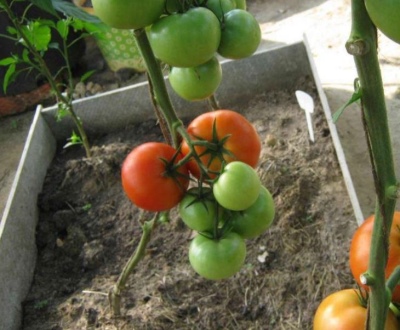
- Authors: Gavrish S.F., Morev V.V., Amcheslavskaya E.V., Volok O.A., Nesterovich A.N.
- Year of approval: 2006
- Category: hybrid
- Growth type: indeterminate
- Appointment: fresh consumption, for pickling and preserving
- Ripening period: late ripening
- Ripening time, days: 118-120
- Growing conditions: for film greenhouses, for greenhouses
- Transportability: good
- Bush size: tall
Self-cultivation of tomatoes on the site requires a lot of knowledge and participation. The grower must comply with the main rules of agricultural technology, namely: plant seedlings on time, water, feed the plants in order to get a rich harvest. The Krasnobay variety requires the same care.
Description of the variety
Krasnobay refers to hybrids with an indeterminate type of growth, which means that it grows constantly, at any stage of the growing season.
The fruits of the described variety are suitable both for conservation and for fresh consumption.
Krasnobay needs to be planted in a greenhouse, it is not suitable for open ground. The bushes are tall and require support. In height, they can reach 2 meters, and sometimes even more. The bush is powerful, with strong foliage. The greens are medium in size, the color is dark green.
The main qualities of the fruit
The fruits of Krasnobay are valued for their excellent transportability. When ripe, they are of a light green hue, when ripe, they turn red. Tomatoes of this variety are large, can reach 371 g. They are slightly ribbed in shape, flat-round.
Up to 8 tomatoes are formed on one brush. Inside there is a tender, but at the same time dense pulp.
Taste characteristics
The taste of Krasnobay is aromatic and sweet.
Ripening and fruiting
This variety is late ripening, ripens in 118-120 days. The harvest begins in July and ends in August.
Yield
The variety belongs to high-yielding tomatoes, up to 8 kg of ripe fruits can be obtained from a square meter.
The timing of planting seedlings and planting in the ground
By the end of February or the beginning of March, you can sow seeds for seedlings, they are transferred to the ground by the end of April.

Growing tomato seedlings is an extremely important process, because it largely depends on whether the gardener will be able to harvest at all. All aspects must be taken into account, from seedbed preparation to planting in the ground.
Landing scheme
The variety is planted according to the scheme 40 x 60 cm.

Growing and care
Krasnobay must be pinned, tied up and shaped, since it grows a lot. When forming, only one stem is left.
Growing Krasnobay tomatoes is best done on well-drained, warm and well-fertilized soils with humus.The soil must be dug deep and enriched with manure or compost. Regular watering and feeding with organic fertilizers are essential care steps, especially during fruit setting. Instead of mineral fertilizers, you can use organic, nitrogen-rich, for example, nettle compost, which has a very good effect on the growth and taste of tomato fruits.
Care should be taken when caring for tomatoes, as over-watering negatively affects the taste of the fruit. Plants should be watered at the root; industrial greenhouses use a drip irrigation system to avoid wetting the leaves.
After planting tomatoes at their destination, you need to tie them up. For support, it is worth choosing metal trellises, since pathogenic fungi are easily transferred from wooden ones. You can also tie a red-haired guy to a stretched wire and rope. Thanks to the binding, the bushes will not fall to the ground when pouring the fruit.
Another procedure, no less important in the care, is the removal of lateral shoots. To do this, only the main stem is left on the plant, and all other shoots appearing from the leaf axils must be removed. Thanks to pinching, tomatoes will begin to bear fruit faster, and the fruits will be larger.




A plant needs different micronutrients at each stage of growth. All fertilizers can be divided into two groups: mineral and organic. Folk remedies are often used: iodine, yeast, bird droppings, eggshells.
It is important to observe the rate and period of feeding. This also applies to folk remedies and organic fertilizers.
Disease and pest resistance
The variety is praised for its high resistance to cracking, as well as good immunity to the following diseases:
cladosporiosis;
tobacco mosaic virus;
fusarium wilting.
Despite the good resistance to some diseases, professionals advise to regularly sprinkle Krasnobay with copper sulfate in order to protect it from other diseases. The tomatoes are sprayed every 7 days until the fruit ripens. Neem oil and garlic infusion help from pests.


Resistant to adverse weather conditions
Krasnobay is considered a cold-resistant variety.
Growing regions
The described variety grows well in the northern and northwestern regions, it can be planted in the Central and Volga-Vyatka regions. Quite good results are being achieved in the Central Black Earth Region and in the North Caucasus, as well as in the Middle Volga region.

























































































